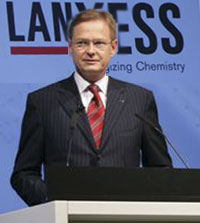 |
 |
E-News Update September 2010 |
LEAD FEATURE |
K2010 NEWS |
COMPANY NEWS |
MATERIALS NEWS |
MACHINERY NEWS |
EXHIBITION NEWS |
RUBBER JOURNAL ASIA |
INJECTION MOULDING ASIA |
Lead Feature
 |
Growth for Lanxess, with Asian PBR site and bio-butyl on the cards
Speciality chemicals company Lanxess may be a new kid on the block, having spun off from the Bayer Group just six years ago, but it is making big strides in the industry. At a media day held in Düsseldorf, Germany, recently, it announced ambitious plans to increase its earnings by 80% in the coming five years. "We intend to issue a solid target of EBITDA (earnings before interest, taxes, depreciation and amortisation) pre-exceptional of EUR1.4 billion in 2015 and will continue to maintain our proven strategies of value, margin and cost," said CEO Axel Heitmann.
This will be up from the EUR800 million it expects this year, which is a tall order says the company given the economic crisis last year and the volatile raw material prices. It can be attributed to what Lanxess says is its successful establishment of its "price-before-volume" strategy. Explained CFO Matthias Zachert, "This means that we pass on rising raw material costs to our customers and that we are even prepared to forego business in certain circumstances if we are unable to achieve the required price levels, which our premium and innovative products deserve."
Increasing EBITDA through investments
Meanwhile, how it plans to increase its EBITDA is to focus on a dual-track growth strategy of organic and external growth, with the former to play a more dominant role. In terms of possible acquisitions, Zachert stressed that the company's current focus is on small to medium-sized acquisitions, similar to the transaction size of past acquisitions. Zachert also added that both organic growth projects and acquisitions must adhere to strict financial criteria.
The growth drivers will continue to be its performance rubber and plastic segments of the business and the BRIC (Brazil, Russia, India and China) countries.
As the world's leading synthetic rubber company, Lanxess is capitalising on the mobility factor, with the tyre market accounting for 25% of its sales and expected to have annual growth rate of 5% up to 2015.
In order to meet this growing demand, Lanxess is pumping in money into this sector. This includes its largest investment to date of EUR400 million earmarked for its 100,000 tonnes/year butyl rubber plant on Jurong Island, Singapore, which will predominantly serve the booming tyre market in Asia when it comes on stream in 2013. In addition, it is expanding its world-scale butyl rubber plant in Belgium - all this should bring in yearly sales of EUR330 million.
"We intend to reduce our focus on budget butadiene products to more high end ones," said Heitmann, in reference to the third generation technology to be implemented at its Singapore butyl plant that will use less steam and have lower emissions.
Together with its output from its plants in Belgium and Canada (totalling 300,000 tonnes), Lanxess will have a total capacity of 700,000 tonnes/year of butyl rubber when the new plant comes on stream.
More PBR and in Asia, too
Another area it is banking on to boost its earnings is the sector for green or high performance tyres. Here, the company is expanding its production capacity for neodymium polybutadiene rubber (Nd-PBR) at its facilities in Dormagen, Germany, Orange, US, and Cabo, Brazil. It will invest EUR20 million on the debottlenecking of its facilities to increase capacity to 50,000 tonnes/year by 2011/2012, to generate sales of EUR70 million/year for its coffers.
But apparently, this will still not be sufficient to meet the growth of 10% a year for Nd-PBR and the company is considering a new production plant in Asia, with a capacity of 100,000 to 150,000 tonnes/year. Certainly, Nd-PBR is an important growth product for the company given that the Asian retread market is growing by 6% a year.
"The site in Asia will be dedicated for the Asian markets, for fuel-efficient tyres," said Heitmann, adding that Singapore is one of the countries being considered for the Nd-PBR facility since Lanxess is already setting up the butyl rubber plant there. "There is space available on the site," said Heitmann, while not confirming if the Nd-PBR plant will be built there.
"The feasibility study is being undertaken at full speed and the countries short listed for the greenfield site will be announced within the next six months," he said, adding that the company was in "serious" negotiations with raw material suppliers and looking at the process technology to be implemented and environment to determine the site selections.
Bio-based butyl rubber on the cards
Lanxess is also jumping on the bandwagon for bio-based products having invested US$10 million in US-based technology development company Gevo, which has created a process (that uses sugars in biomass) to manufacture bio-based isobutylene. "We will bring in Lanxess technology to convert this to isobutene to make bio-butyl. We are working hand in hand with Gevo and the project is running at full speed," said Heitmann, adding that the bio-based isobutene will be on stream in a few years time. Butyl rubber is a copolymer of isobutylene as well as isoprene.
Engineering plastics also vital to growth
Another area that Lanxess is addressing in the mobility trend is in its engineering plastics business, in its Semi-Crystalline Products (SCP) unit, that markets Durethan PA and Pocan PBT, which help to make cars lighter and more fuel-efficient. Growing demand for these products has prompted the company to expand its compounding production in Wuxi, China, by 50% by adding on a third line to bring capacity to 60,000 tonnes/year. Plus, it is building a new compounding plant in Jhagadia, India, with a capacity for 20,000 tonnes/year for Durethan.
It is also rolling out investments totalling EUR50 million in the coming years to expand the production of intermediates such as caprolactam that is needed to manufacture the engineering plastics. "We will expand our capacity to 220,000 tonnes at our facility in Antwerp," said Heitmann.
And Zachert explained, "A competitive raw material supply allows us in turn to expand our compounding facilities in China and to invest in a new capacity in India." Annual sales of EUR80 million are expected from these investments, he added.
